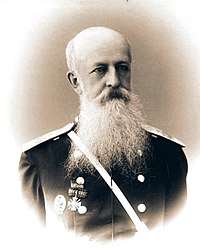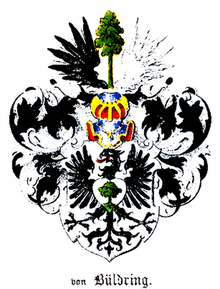Alexander Alexandrovich Bilderling
| Baron Alexander Alexandrovich Bilderling | |
|---|---|
 General Alexander Alexandrovich Bilderling | |
| Born |
5 July [O.S. 23 June] 1846 near Saint Petersburg, Russian Empire |
| Died |
26 July [O.S. 13 July] 1912 (aged 66) Tsarskoye Selo, Saint Petersburg, Russian Empire |
| Buried | Novodevichy Cemetery, Saint Petersburg, Russia |
| Allegiance |
|
| Service/ |
|
| Years of service | 1866-1905 |
| Rank | General of the Cavalry |
| Commands held |
17th European Army Corps Third Manchurian Army |
| Battles/wars |
Russo-Turkish War Russo-Japanese War |
| Awards | see below |
Baron Alexander Alexandrovich Bilderling (Russian: Александр Александрович Бильдерлинг; German: Alexander Freiherr[1] von Bilderling or Büldring-Bilterling) (5 July [O.S. 23 June] 1846 – 26 July [O.S. 13 July] 1912) was a Russian general of German descent, noted for this role in the Russo-Japanese War and an artist and monument designer.
Biography
Family

Alexander Alexandrovich Bilderling was born on July 5, 1844 in Saint Petersburg into the Baltic German Noble family of Büldring-Bilterling (also known as Bilderling) originated from Westphalia. His father, Alexander Otto Hermann Freiherr von Büldring-Bilterling, who was an officer in the Imperial Guards, had since converted to Orthodoxy and changed his name to Alexander Grigoriyevich Bilderling. And his grandfather, Georg Friedrich Sigismund Freiherr von Büldring-Bilterling, a Lutheran pastor in Jelgava.
Career
He graduated with honors from the Page Corps and was commissioned as a cavalry lieutenant in 1864 and promoted to captain in 1866. He graduated from the General Staff Academy in 1870 and served in the Kiev Military District from 1870-1875. Promoted to colonel in 1872, he became commandant of the Tver Cavalry Academy in 1875 and was assigned command of the 12th Dragoon Regiment in 1877 and became commandant of the prestigious Nikolaev Cavalry School in 1878.
From 1877-1878, Bilderling participated in the Russo-Turkish War. He joined the General Staff in 1891 and was promoted to lieutenant-general in 1892. In 1899, he became commander of the 17th Army Corps and was promoted to general of cavalry in 1901.
During the Russo-Japanese War of 1904-1905, Bilderling commanded the 17th European Army Corps from May 1904, accompanying it to Manchuria in the summer of the same year. He was in command of the eastern flank at the Battle of Liaoyang, and the western flank at the Battle of Shaho. After the Battle of Sandepu, Bilderling replaced Alexander Kaulbars as commander of the Third Manchurian Army. However, after the Battle of Mukden, he was relieved of his command from May–September 1905, and was replaced as commander of the Third Manchurian Army by General Mikhail Batyanov. He was later bitterly blamed by General Aleksey Kuropatkin for the defeat. He served as a member of the Board of War from 1905-1912.[2]
In addition to his military career, Bilderling was also a painter of note, and designer of monuments. In his declining years, he participated in commissions for installing monuments and organizing commemorative activities.
He was buried at the Novodevichy Cemetery in Saint Petersburg, but his grave is not preserved.
Awards
.png)
.png)
.png)






References
- Connaughton, R. M. (1988). The War of the Rising Sun and the Tumbling Bear—A Military History of the Russo-Japanese War 1904–5. London. ISBN 0-415-00906-5.
- Jukes, Geoffry. The Russo-Japanese War 1904–1905. Osprey Essential Histories. (2002). ISBN 978-1-84176-446-7.
- Kowner, Rotem (2006). Historical Dictionary of the Russo-Japanese War. The Scarecrow Press. ISBN 0-8108-4927-5.